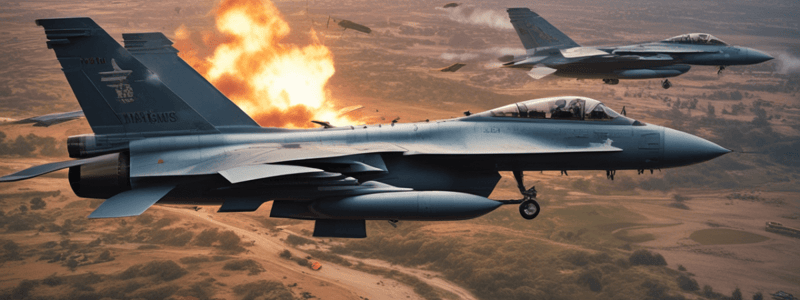Podcast
Questions and Answers
What is the primary objective of the U.S. military's airstrikes in the Middle East?
What is the primary objective of the U.S. military's airstrikes in the Middle East?
- To counteract potential threats from Iran-backed militia groups (correct)
- To establish a military presence in Iraq and Syria
- To support the Houthi rebels in Yemen
- To destabilize the governments of the targeted regions
Which specific targets have been the focus of U.S. airstrikes in Yemen?
Which specific targets have been the focus of U.S. airstrikes in Yemen?
- Houthi surface-to-air missile systems (correct)
- Humanitarian aid convoys
- Civilian population centers
- Oil refineries and pipelines
How many attacks on U.S. military installations have been carried out by Iran-backed militias since October 18, 2023?
How many attacks on U.S. military installations have been carried out by Iran-backed militias since October 18, 2023?
- 214
- 307
- 92
- 166 (correct)
What type of threats have prompted the U.S. military's missile engagements in the Middle East?
What type of threats have prompted the U.S. military's missile engagements in the Middle East?
Which of the following statements is NOT true regarding the U.S. military's airstrikes?
Which of the following statements is NOT true regarding the U.S. military's airstrikes?
What is the total number of incoming missiles, rockets, and drones that the U.S. military has intercepted and engaged, according to the text?
What is the total number of incoming missiles, rockets, and drones that the U.S. military has intercepted and engaged, according to the text?
Flashcards are hidden until you start studying
Study Notes
US Military Airstrikes and Missile Threat
Introduction
The U.S. military has been conducting airstrikes in various regions, particularly in the Middle East, as part of its efforts to counteract potential threats to its interests and personnel. These airstrikes have primarily focused on Iran-backed militia groups, such as the Houthis in Yemen, which have been attacking U.S. military installations and civilian infrastructure. The recent escalation in these attacks has led to increased U.S. military intervention in the form of airstrikes and missile engagements.
US Military Airstrikes
The U.S. military has been actively striking enemy targets in regions where threats have emerged. For example, the U.S. conducted a series of strikes against Houthi military targets in Yemen that were deemed an imminent threat. Additionally, the U.S. has targeted Iran-backed militias in Iraq and Syria, resulting in a total of 166 attacks on U.S. military installations since October 18, 2023. These strikes have included the destruction of Houthi surface-to-air missiles, which pose a significant threat to U.S. aircraft in the region.
Missile Engagement
Missile engagement has become a crucial aspect of the U.S. military's strategy in the Middle East. The U.S. has intercepted numerous incoming missiles, rockets, and drones targeting commercial and other Navy vessels. For instance, the U.S. has taken out dozens of incoming missiles, rockets, and drones targeting commercial and other Navy vessels.
Strategic Significance
These military airstrikes and missile engagements serve several purposes. Firstly, they aim to protect U.S. interests and personnel from harm. Secondly, they demonstrate the U.S.'s commitment to deterring hostile actors from threatening international security. Thirdly, they send a message to other nations that the U.S. will not tolerate aggressive behavior towards its allies and partners.
In conclusion, the U.S. military has been involved in a series of airstrikes and missile engagements in various regions, notably the Middle East, in response to perceived threats to its interests and personnel. These actions serve to protect U.S. assets, deter hostile acts, and uphold international security norms.
Studying That Suits You
Use AI to generate personalized quizzes and flashcards to suit your learning preferences.




